The master who conquered death ... through Power Point. Book review by A. Kapterev “Presentation Mastery”
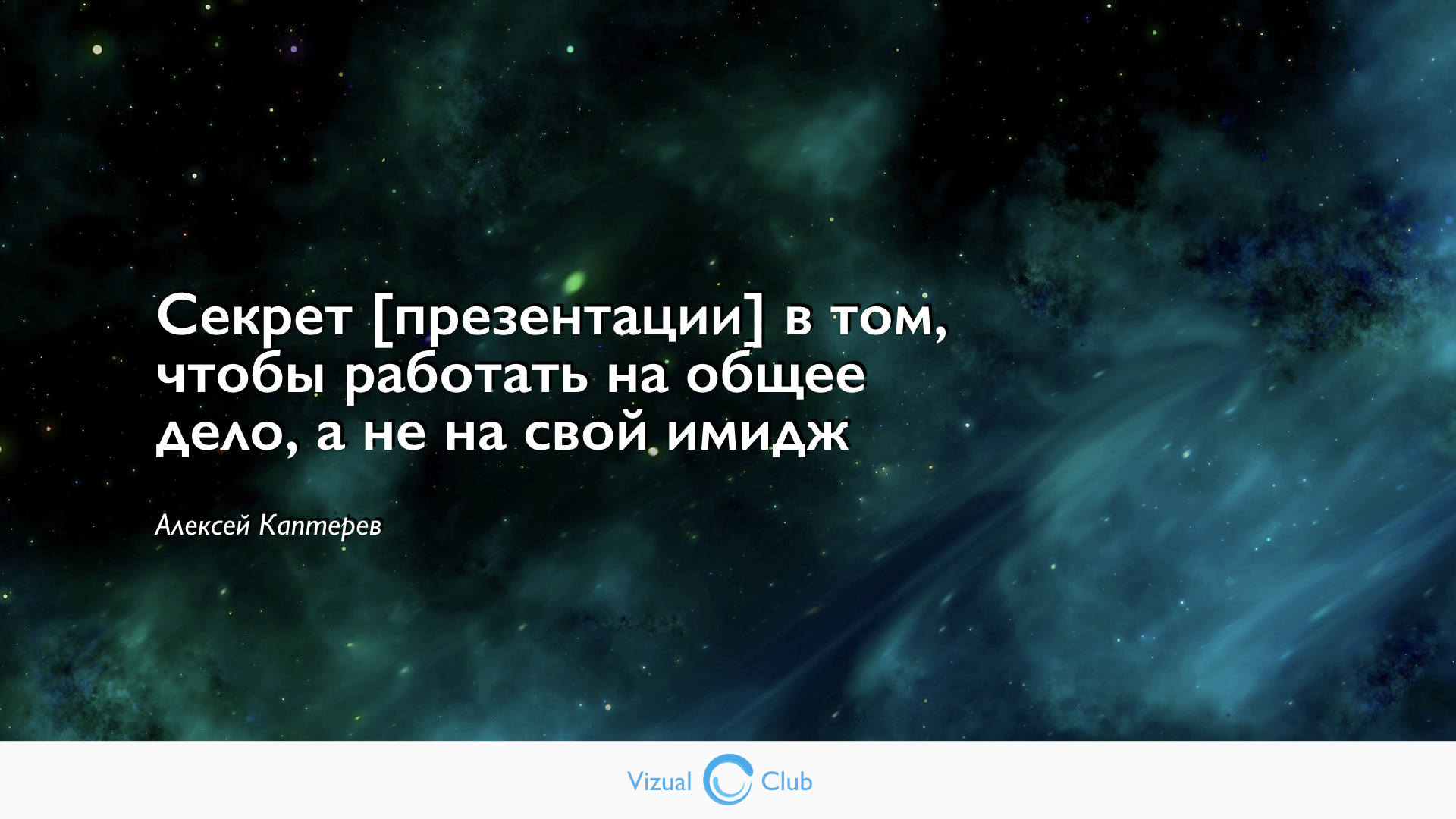
When I worked as a teacher in high school, I watched student presentations from time to time. Topics were the most useful, the material - the most exciting. But the presentations were terrible .
Despite the fact that presentations are in school programs, they are made in almost all subjects (in all universities of the country), a good student presentation is worth its weight in gold. My attempts to improve the situation were not always successful - there is no separate time in a foreign language education program to analyze this important, but not an easy topic. Therefore, again and again, I died from text typed by Comic Sans 12 size on an acid-green slide. Over and over again, I watched how this text was read and then the clipart man flew in a spiral.
')
This problem was described by Alexey Kapterev in the famous presentation “Death through Power Point (and how to escape from it)” . I first saw it in English, and I really liked it. Like the millions of Slideshare users. Then I was interested in the person who created this hit.
Everywhere, wherever the author was mentioned, it was about this presentation and about the book “Presentation Mastery. How to create presentations that can change the world . ” The book attracted by the fact that it was first published in English and earned recognition in the western market. But the topic of presentations and the “sale of ideas” has always been considered the “trump card” of Western specialists - businessmen, their trainers and designers. In general, all these facts formed an intrigue, and curiosity made me buy a book.
Overall impression
The original title of the work is “Presentation Secrets. Never Thought Possible with Your Presentations, "Literally" Secrets of the presentation. Do what you have always thought impossible with your presentations. ” (Heroic, ambitious and American immodest name, I think). As you can see, the translation of the Russian-language version is slightly changed, but this “swing” to globality is preserved. I agree with the author, because I also believe that the ability to convey a thought helps to do the impossible and solve the biggest problems. Historical examples of this are many.
pros

1. The book is easy to read because it resembles a conversation or, rather, a dialogue-presentation. Alexey Kapterev poses questions and answers them, offers tasks for implementation, jokes. Therefore, 330 pages of the book are read somehow quickly.
2. In the process of reading is involved in the activity . Quite unexpectedly, I watched a four-hour film, which is referred to in the chapter about storytelling. I looked through the most popular presentations in the world, which are written in the work. Visited several interesting sites. It is all organically woven into the story, which allows you to compare this book with a full-fledged training or a few living activities.
3. The text perfectly combines theory and practice . The work is devoted primarily to practical skills and specific "working" tools. But to prove their effectiveness, the author uses scientific facts and the results of modern research. Therefore, all formulated rules and principles are convincing.
Minuses

1. Some rules and principles are idealized . Unfortunately, not all the principles described in the book work in Russian reality. I had to give presentations to the audience of officials and the “American” goodwill and openness were perceived, rather, as stupidity and insecurity.
In the minds of many Russians, the ideal speaker is not the same as Western authors draw it. Insolent, despotic, not necessarily highly intelligent, not necessarily speaking the right (and honest) things, the main thing is rich and / or influential.
I saw wonderful performances by enthusiastic, persuasive, sincere experts whom the audience did not perceive. And he saw incompetent speakers unable to relate the two words, and the audience laughed at unfunny jokes, nodded vague statements and sincerely clapped at the end of the presentation.
My observations (including the behavior of students) showed that “civilized” rules work in the audience with “advanced” spectators . Perhaps, for the Russian-language edition you need a note that some of the rules outlined are an ideal, to which you need to try to “pull down” your viewers (or educate them within these principles).
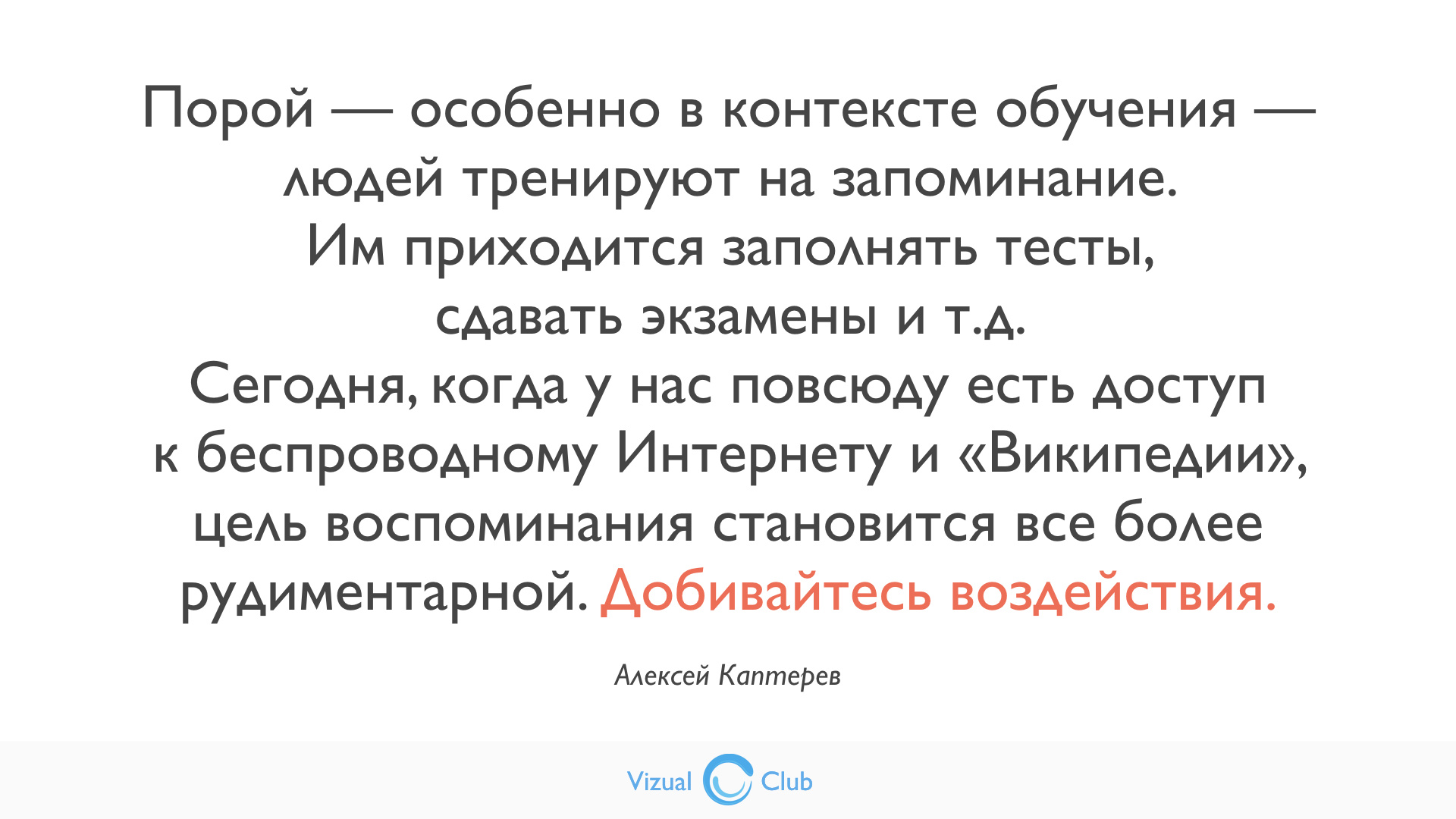
2. Alexey Kapterev underestimates the role of memory in the presentation. He writes that memory in the modern world is increasingly rudimentary, since There is a constant access to the network - a repository of memories. The only thing you need to strive for is the impact - you need to inspire your audience for actions and changes. In education, it is impossible every day to inspire students to great achievements. This threatens with the teacher's emotional burnout and the student's feeling that he doesn’t have to memorize anything, doesn’t have to constantly work. Motivation without awareness of the need to strain your memory turns learning into entertainment.
What it is really necessary to convince students is that it is necessary to work on oneself, to develop, to make conscious efforts to it. But then you need to shift the focus on the specific content of the work.
Although this disadvantage can not be considered a disadvantage, because the book is devoted to a business presentation, which is still different from the educational one.
Book structure
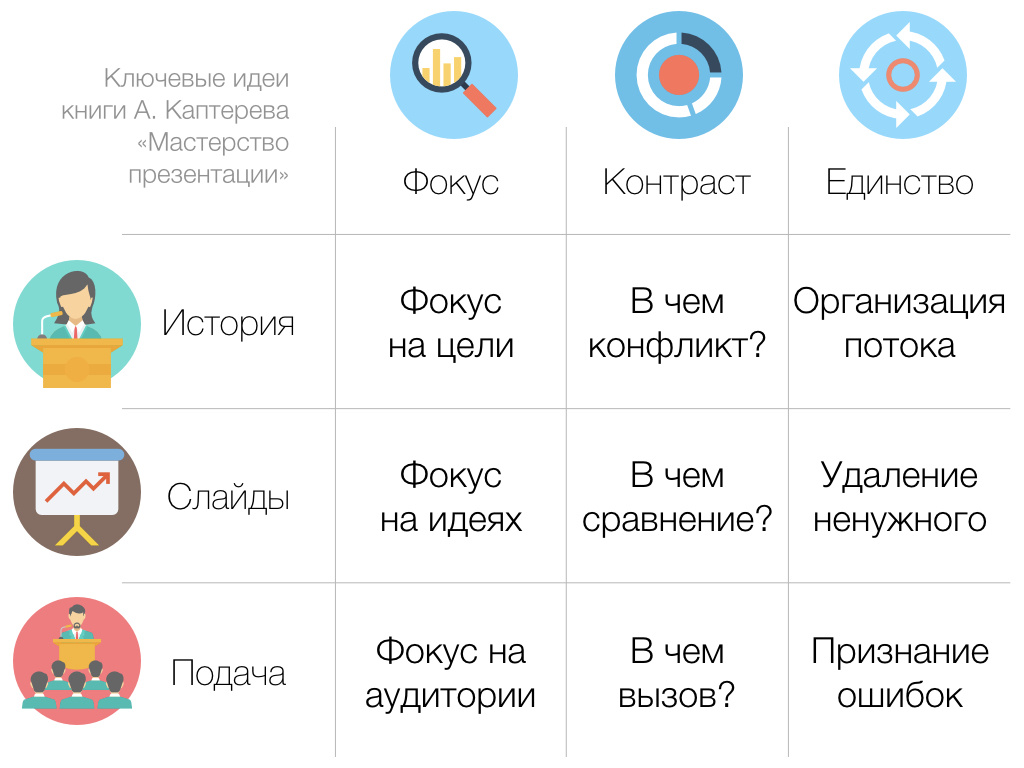
The logic of presentation deserves special mention - it is perfectly thought out. On page 314 there is a 3 x 3 table, summarizing the content of the book - these are the nine most important ideas concerning the focus, contrast and unity of the story, slides and presentation. "Skeleton" principles of quality presentation and made the content. Such a structure helps to remember the essence, to understand the connection of chapters and parts with each other.
After each chapter there is a summary - it is very convenient, because in a few seconds, you can refresh the contents of the chapter and use the book as a textbook or practical guide.
How to tell stories (chapter on storytelling)
At the heart of every good presentation is a good story (or several). Storytelling is the ability to build the necessary facts into a sequence and connect them with each other and with the aim of speaking (the principle of unity).
The author builds goals in order of importance:
- minimum goal - so that people can hear you,
- the next target is memorized
- further actions (go and do what you told them)
- and the maximum goal - they became better , changed, defeated the problem, as you showed them.
The goal should be what you truly believe in, without it it will be difficult (the principle of focus ). The following quote about the purpose of the presentation and sincerity I applaud while standing.
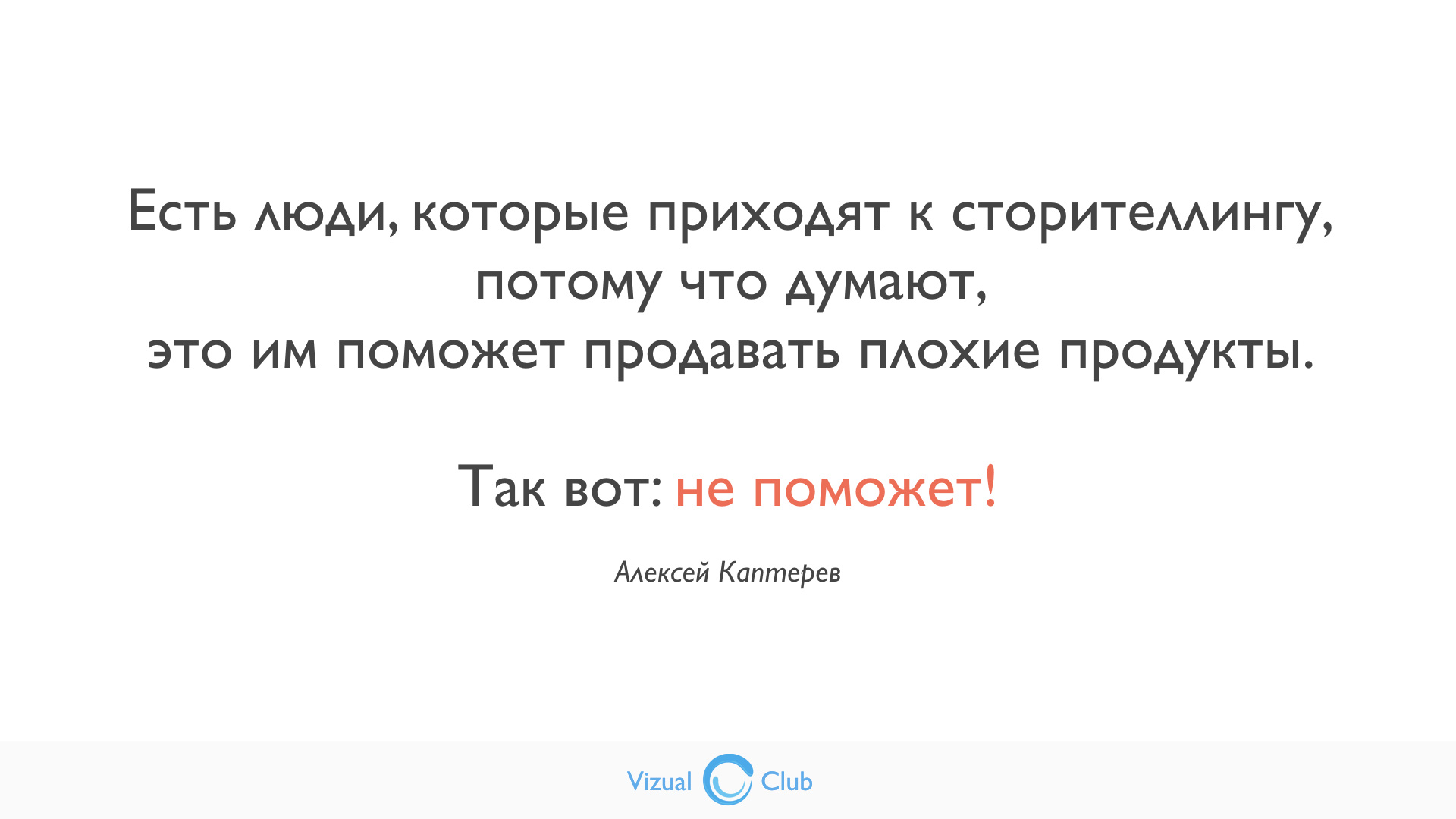
The story - the skeleton of the presentation - should appeal to the emotions of the listeners, “hook on the living.” For this, there must be a conflict in history (the principle of contrast ).
There are 4 types of conflicts in storytelling:
- With himself (the hero has unresolved internal problems that are expressed externally),
- With another person / company (comparing values or achievements, demonstrating the advantages of your hero),
- With a dominant paradigm (an outsider hero who challenges such a major competitor or unbreakable stereotypes, the myth of David and Goliath),
- With external forces (nature, fate, human capabilities, economy and other forces that must have some kind of external expression, not to be abstract).
Comparisons that follow the principles help tell the story:
- Recognition (to compare something new with the well-known, for example, a new MacBook Air is placed in a regular envelope for documents).
- The birth of emotions (death, sex, politics, religion).
- May be obvious (without a jacket "Jimmy two jackets" will be the usual Jimmy).
- Avoiding unpredictable associations when comparing (for example, religious topics can give rise to a variety of associations, negative ones should be avoided).
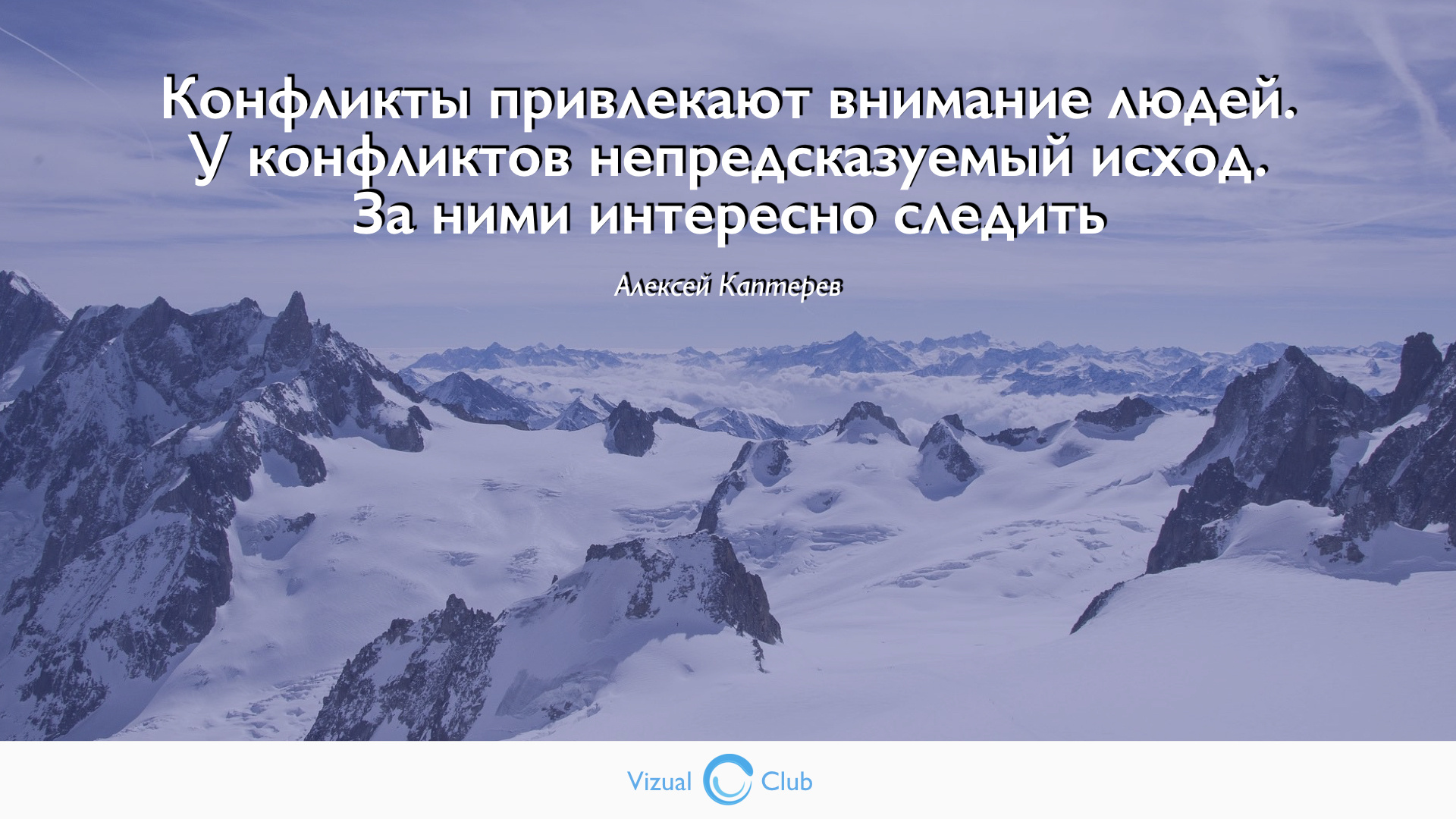
To organize information, you can use a list, but not more than 4 points - this is the limit of our short-term memory, according to the researchers.
The author offers 5 ways to organize information for better learning:
- unifying metaphoric image
- alphabet (acronyms, list letters make up a word),
- sequence of events
- hierarchy,
- categories (some kind of unifying feature).
What you need for a good slide design (second chapter)
In the slide design, the author adheres to the ideas of G. Reynolds (Zen presentation), Edward Taffy (design is not “decoration”, but the meaning), J. Zelazny and other recognized “classics of the genre”.
In the design of the slide should focus on the meaning of the presentation, its purpose ( principle of focus ). Viewers should not have a choice, what to look at, design and performance should obviously indicate the main thing in each idea and on each slide.

The meaning is gradually revealed in history, in visual conflict, comparisons (the principle of contrast ). To highlight and emphasize the main thing, a good slide needs a contrast - in colors, fonts, forms, diagrams.
Speaking about fonts, Alexey Kapterev formulates an excellent rule:
Exquisite, complex font is good for remembering, and easy, simple - for call to action.That is, the audience will better remember the idea, decorated with a complex font, but it will make more quickly and more willingly what is typed in a simple font.
This rule applies not only to fonts.
If the slide calling for action is visually complex, then the audience is more likely to remember it, but less so if it takes up the task.The idea that the diagrams must be “alive” is also productive, they must contain dramaturgy, action, dynamics:
Most good diagrams or move something somewhere or something are compared with something.And the third principle - unity - is that all the excess must be mercilessly removed from the slides. An intricate, loaded slide will “eat up” the precious attention of the audience and the time of the presentation.

How to perform in public with presentations (the chapter on convincing people)
In the third chapter, Alexey Kapterev shares the secrets of public speaking: how to behave in public, keep attention, answer questions, etc.
To focus on the audience (especially if there are many people), you need two things:
- Know the content of your presentation,
- To look at individuals in the hall, to communicate with them (not to “broadcast” into emptiness, abstractly).
The principle of contrast in the flow - is the presence of a call - a call to the audience for emotions, arguments, vigorous actions, laughter. One cannot but agree with the author: “New ideas that do not risk offending someone are not really new ideas.”
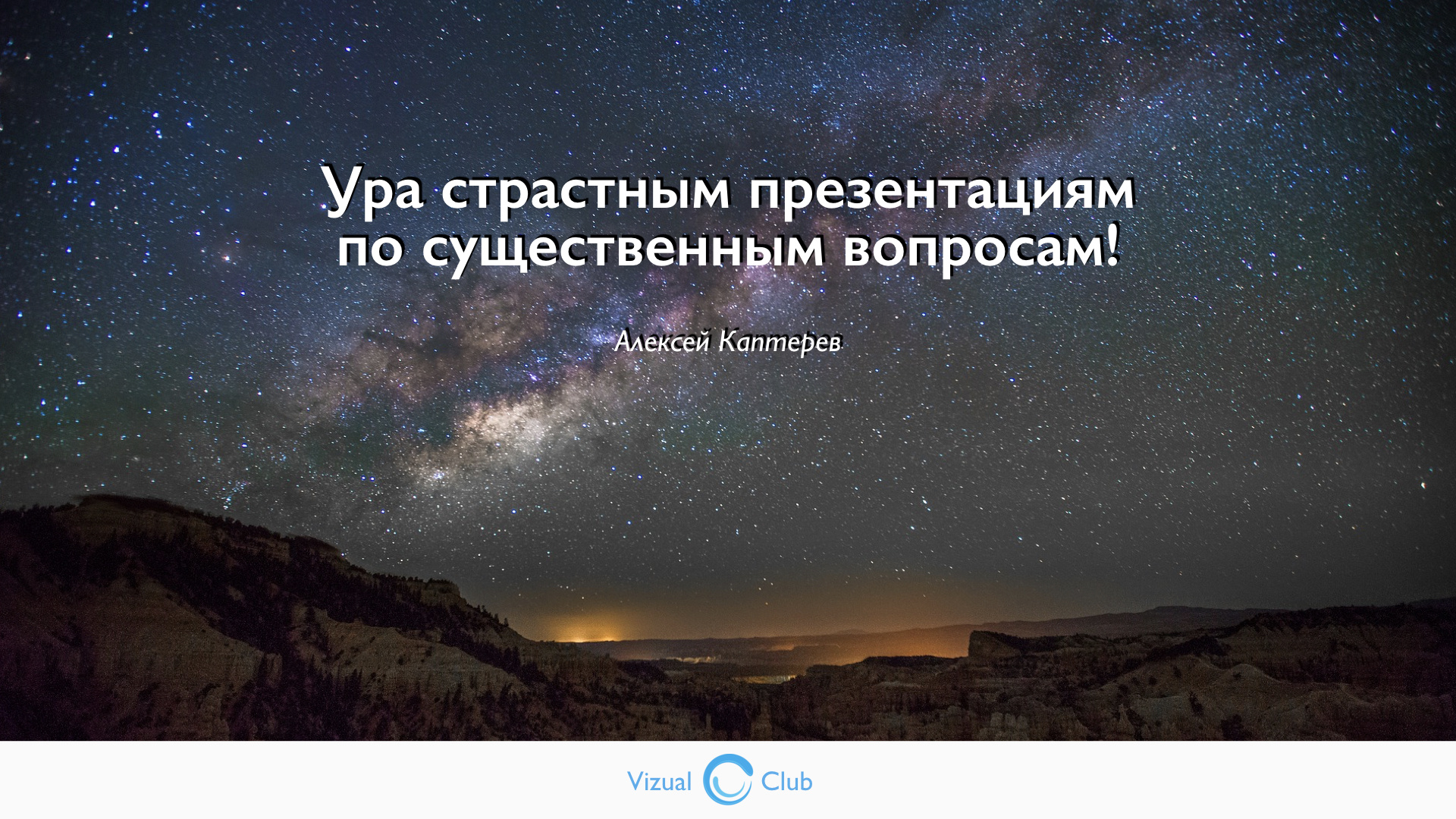
Two excellent, effective, (tested on students) methods of ridiculing that help motivate people to action:
- a change of context (a flaw characteristic of the audience is attributed to another group and is ridiculed; the audience laughs, condemns, as it were, someone else's trait or behavior, but they work on themselves).
- criticism with great exaggeration (the seven deadly sins of the presentation).
Unity in submission is realized in adherence to the ideas expressed. In sincerity, unity with the audience, the ability to laugh at yourself and admit your mistakes .
Despite the fact that you are in the position of a teacher, be prepared to learn. If you do not want to learn, none of those present will want to.The students asked: “Why do we have to make presentations at the university? They will not be useful to us in the work! ”. But this question has never puzzled me. I answered approximately as the presentation master Aleksey Kapterev says in a book that I advise everyone who reads to the public to read.
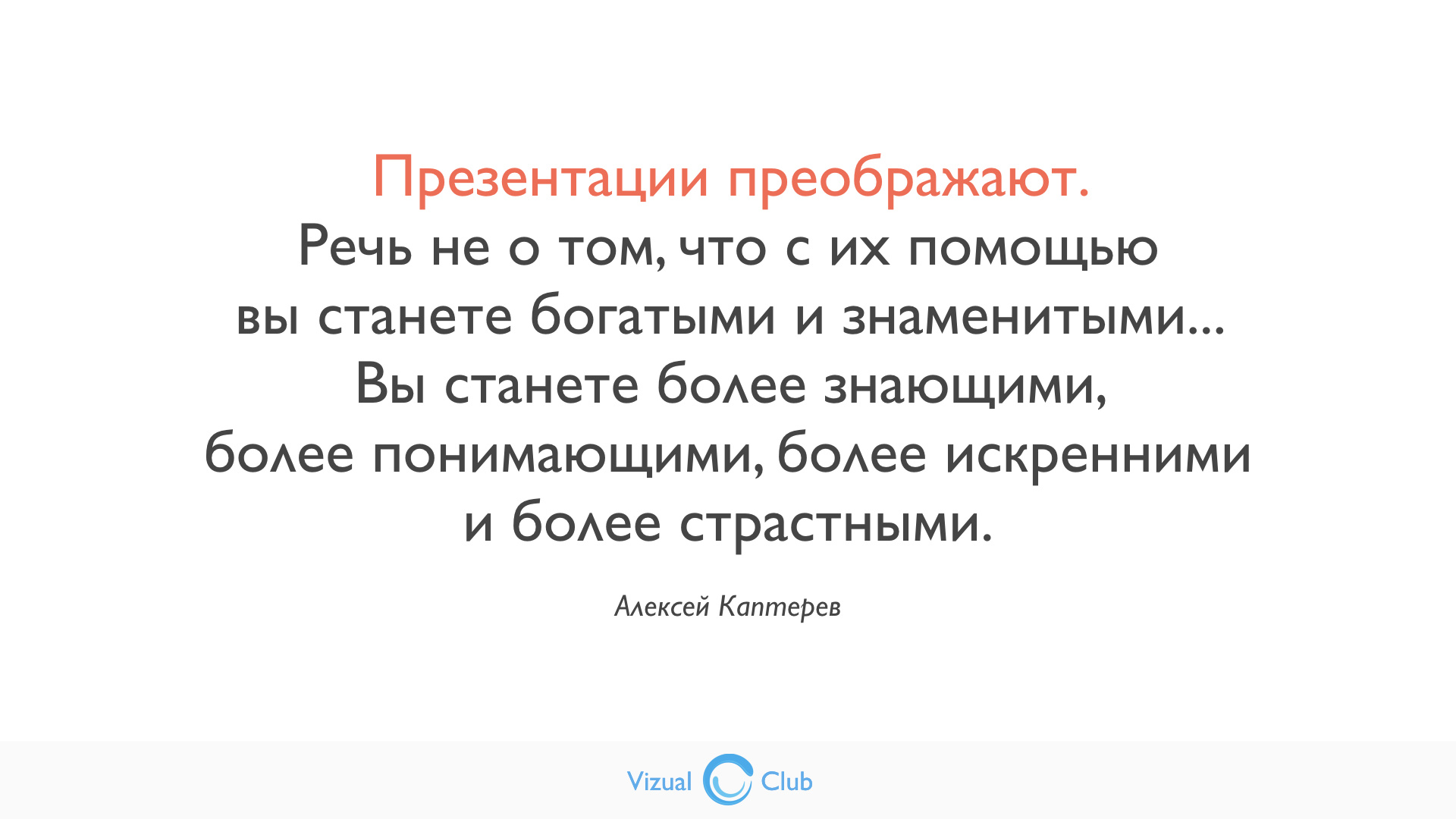
Source: https://habr.com/ru/post/335518/
All Articles